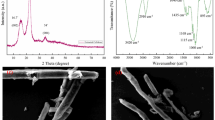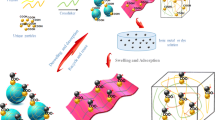Abstract
Acrylamide/chitosan-based cryogel was fabricated, and a triazine dye, Reactive Green 5, was attached to the cryogel by nucleophilic substitution to build a dye affinity support for adsorption of catalase enzyme. Characterization of cryogel was performed using FTIR, SEM, EDX, BET, and swelling test. Synthesized cryogel beared pores with ~ 200 μm in size and the surface area of 11.8 m2/g. Maximum catalase adsorption was (17.6 ± 0.29 mg/g) measured at pH 4.0 and 25 °C. The adsorption sites on the cryogel were saturated at 0.75 mg/mL enzyme concentration. Increased ionic strength caused a decrease in adsorption capacity. Desorption of catalase from cryogel was enabled using 0.5 M NaSCN solution. Consecutive adsorption experiments were carried out fifteen times to evaluate the reusability of the cryogel. Thermal, storage, and operational stabilities of immobilized catalase were higher than the free one. The data produced implicate that catalase-adsorbed dye-affinity cryogel may be used for H2O2 detection or removal when necessary.

Graphical Abstract














Similar content being viewed by others
Change history
03 August 2020
The original version of this article unfortunately contained a mistake.
References
Krajewska, B. (2004). Application of chitin- and chitosan-based materials for enzyme immobilizations: a review. Enzyme and Microbial Technology, 35(2–3), 126–139.
Grigoras, A. G. (2017). Catalase immobilization—a review. Biochemical Engineering Journal, 117, 1–20.
Lozinsky, V. I., Plieva, F. M., Galaev, I. Y., & Mattiasson, B. (2001). The potential of polymeric cryogels in bioseparation. Bioseparation, 10(4–5), 163–188.
Memic, A., Colombani, T., Eggermont, L. J., Rezaeeyazdi, M., Steingold, J., Rogers, Z. J., KNavare, J., Mohammed, H. S., & Bencherif, S. A. (2019). Latest advances in cryogel technology for biomedical applications. Advances in Therapy, 2(4), 1800114.
Saini, R. K., Bagri, L. P., & Bajpai, A. K. (2019). Nano-silver hydroxyapatite based antibacterial 3D scaffolds of gelatin/alginate/poly (vinyl alcohol) for bone tissue engineering applications. Colloids Surf. B, 177, 211–218.
de Oliveira, A. C. F., Neves, I. C. O., Saraiva, J. A. M., de Carvalho, M. F. F., Batista, G. A., Veríssimo, L. A. A., & Resende, J. V. D. (2019). Capture of lysozyme on macroporous cryogels by hydrophobic affinity chromatography. Separation Science and Technology, 1–13.
Li, J., Wang, Y., Zhang, L., Xu, Z., Dai, H., & Wu, W. (2019). Nanocellulose/gelatin composite cryogels for controlled drug release. ACS Sustainable Chemistry & Engineering, 7(6), 6381–6389.
Bayramoglu, G., & Arica, M. Y. (2010). Reversible immobilization of catalase on fibrous polymer grafted and metal chelated chitosan membrane. Journal of Molecular Catalysis B: Enzymatic, 62(3–4), 297–304.
Shakya, A. K., Sharma, P., & Kumar, A. (2010). Synthesis and characterization of thermo-responsive poly (N-isopropylacrylamide)-bovine liver catalase bioconjugate. Enzyme and Microbial Technology, 47(6), 277–282.
Alptekin, Ö., Tükel, S. S., Yıldırım, D., & Alagöz, D. (2010). Immobilization of catalase onto Eupergit C and its characterization. Journal of Molecular Catalysis B: Enzymatic, 64(3–4), 177–183.
Orhan, H., Evli, S., Dabanca, M. B., Başbülbül, G., Uygun, M., & Uygun, D. A. (2019). Bacteria killer enzyme attached magnetic nanoparticles. Materials Science and Engineering: C, 94, 558–564.
Bayramoğlu, G., & Arıca, M. Y. (2002). Procion Green H-4G immobilized on a new IPN hydrogel membrane composed of poly (2-hydroxyethylmethacrylate)/chitosan: preparation and its application to the adsorption of lysozyme. Colloids and Surfaces A: Physicochemical and Engineering Aspects, 202(1), 41–52.
Wongchuphan, R., Tey, B. T., Tan, W. S., Taip, F. S., Kamal, S. M. M., & Ling, T. C. (2009). Application of dye-ligands affinity adsorbent in capturing of rabbit immunoglobulin G. Biochemical Engineering Journal, 45(3), 232–238.
Bayramoglu, G., Oktem, H. A., & Arica, M. Y. (2007). A dye–ligand immobilized poly (2-hydroxyethylmethacrylate) membrane used for adsorption and isolation of immunoglobulin G. Biochemical Engineering Journal, 34(2), 147–155.
Jain, E., & Kumar, A. (2009). Designing supermacroporous cryogels based on polyacrylonitrile and a polyacrylamide-chitosan semi-interpenetrating network. Journal of Biomaterials Science. Polymer Edition, 20(7-8), 877–902.
Uygun, D. A., Akduman, B., Uygun, M., Akgöl, S., & Denizli, A. (2012). Purification of papain using Reactive Green 5 attached supermacroporous monolithic cryogel. Applied Biochemistry and Biotechnology, 167(3), 552–563.
Bradford, M. M. (1976). A rapid and sensitive method for the quantitation of microgram quantities of protein utilizing the principle of protein-dye binding. Analytical Biochemistry, 72(1–2), 248–254.
Beers, R. F., & Sizer, I. W. (1952). A spectrophotometric method for measuring the breakdown of hydrogen peroxide by catalase. The Journal of Biological Chemistry, 195(1), 133–140.
Tüzmen, N., Kalburcu, T., & Denizli, A. (2012). Immobilization of catalase via adsorption onto metal-chelated affinity cryogels. Process Biochemistry, 47(1), 26–33.
Bayramoglu, G., Karagoz, B., Yilmaz, M., Bicak, N., & Arica, M. Y. (2011). Immobilization of catalase via adsorption on poly (styrene-d-glycidylmethacrylate) grafted and tetraethyldiethylenetriamine ligand attached microbeads. Bioresource Technology, 102(4), 3653–3661.
Inanan, T., Tüzmen, N., & Karipcin, F. (2018). Oxime-functionalized cryogel disks for catalase immobilization. International Journal of Biological Macromolecules, 114, 812–820.
Yılmaz, F., Bereli, N., Yavuz, H., & Denizli, A. (2009). Supermacroporous hydrophobic affinity cryogels for protein chromatography. Biochemical Engineering Journal, 43(3), 272–279.
Uygun, M., Akduman, B., Akgöl, S., & Denizli, A. (2013). A new metal-chelated cryogel for reversible immobilization of urease. Applied Biochemistry and Biotechnology, 170(8), 1815–1826.
Ratanasumawong, S., Hagiwara, T., & Sakiyama, T. (2015). Effect of sodium chloride on the adsorption of proteins from pink shrimp (Pandalus eous) onto stainless steel surfaces. Food Science and Technology Research, 21(3), 327–331.
Göktürk, I., & Perçin, I. (2016). Catalase purification from rat liver with iron-chelated poly (hydroxyethyl methacrylate-N-methacryloyl-(l)-glutamic acid) cryogel discs. Prep Biochem Biotech., 46(6), 602–609.
Zhu, X., & Alexandratos, S. D. (2005). Polystyrene-supported amines: affinity for mercury (II) as a function of the pendant groups and the Hg (II) counterion. Industrial and Engineering Chemistry Research, 44(23), 8605–8610.
Tehrani, H. S., & Moosavi-Movahedi, A. A. (2018). Catalase and its mysteries. Progress in Biophysics and Molecular Biology., 140, 5–12.
Kaushal, J., Singh, G., & Arya, S. K. (2018). Immobilization of catalase onto chitosan and chitosan–bentonite complex: a comparative study. Biotechnology Reports., 18, e00258.
Doğaç, Y. I., Çinar, M., & Teke, M. (2015). Improving of catalase stability properties by encapsulation in alginate/Fe3O4 magnetic composite beads for enzymatic removal of H2O2. Preparative Biochemistry & Biotechnology., 45(2), 144–157.
Rogalski, J., Szczodrak, J., Pleszczyńska, M., & Fiedurek, J. (1997). Immobilisation and kinetics of Penicillium notatum dextranase on controlled porous glass. Journal of Molecular Catalysis B: Enzymatic, 3(6), 271–283.
Bayramoglu, G., Salih, B., Akbulut, A., & Arica, M. Y. (2019). Biodegradation of Cibacron Blue 3GA by insolubilized laccase and identification of enzymatic byproduct using MALDI-ToF-MS: toxicity assessment studies by Daphnia magna and Chlorella vulgaris. Ecotoxicology and Environmental Safety., 170, 453–460.
Author information
Authors and Affiliations
Corresponding author
Ethics declarations
Conflict of Interest
The authors declare that they have no conflict of interest to disclose.
Additional information
Publisher’s Note
Springer Nature remains neutral with regard to jurisdictional claims in published maps and institutional affiliations.
Highlights
• Reactive Green 5 bearing polyacrylamide/chitosan cryogel was synthesized by attaching the dye via nucleophilic substitution.
• Structural characterization of cryogel was carried out by FTIR, SEM, EDX, BET, and swelling test.
• Catalase enzyme was immobilized onto Reactive Green 5 bearing polyacrylamide/chitosan cryogel by adsorption, and conditions for maximum adsorption were determined.
• Kinetic properties of free and immobilized catalase enzymes were evaluated.
Rights and permissions
About this article
Cite this article
Yavaşer, R., Karagözler, A.A. Reactive Green 5–Decorated Polyacrylamide/Chitosan Cryogel: An Affinity Matrix for Catalase. Appl Biochem Biotechnol 192, 1191–1206 (2020). https://doi.org/10.1007/s12010-020-03393-9
Received:
Accepted:
Published:
Issue Date:
DOI: https://doi.org/10.1007/s12010-020-03393-9




